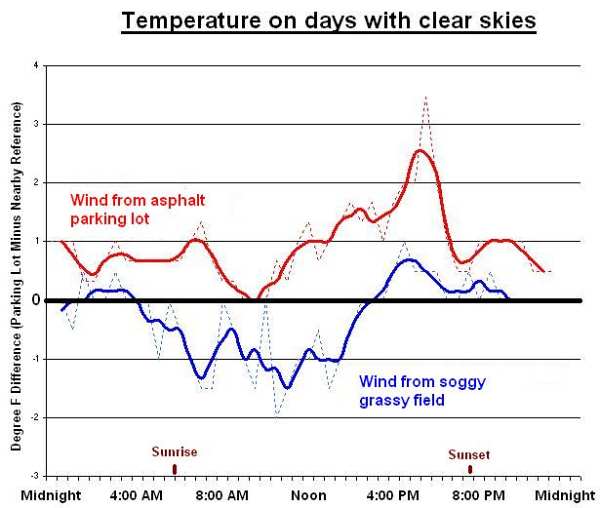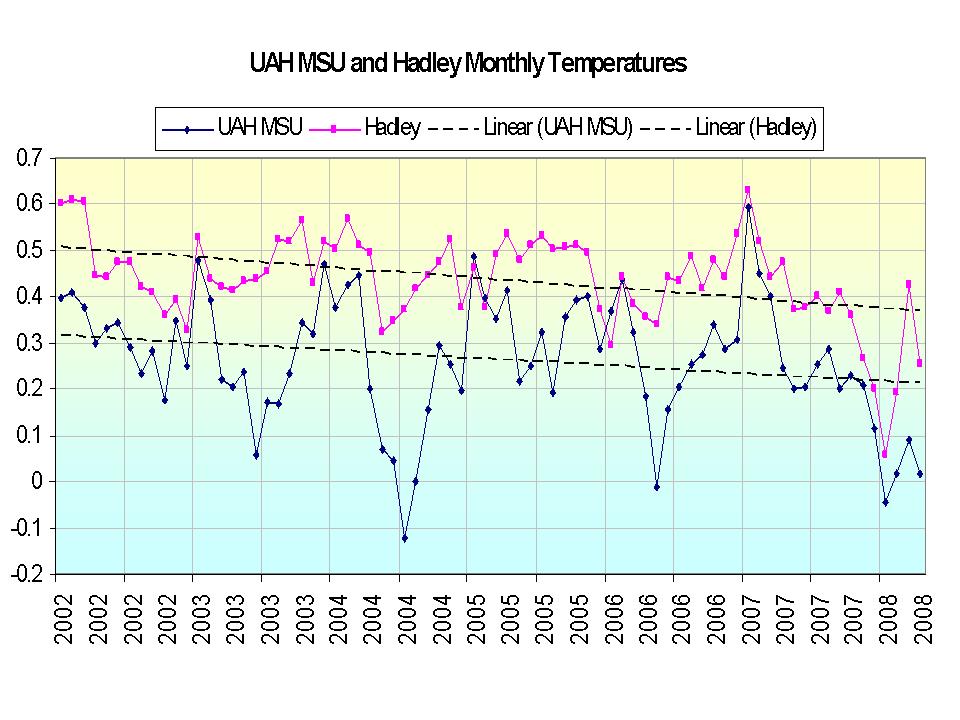This helpful quiz produced by Australian environmentalcases tells kids when they should die, but for some reason environmentalists don’t seem to be leading by example.
Apparently my time was up at 7.3 years:
h/t.
This helpful quiz produced by Australian environmentalcases tells kids when they should die, but for some reason environmentalists don’t seem to be leading by example.
Apparently my time was up at 7.3 years:
h/t.
The “Parking Lot Effect.

Assessment of the reliability of climate predictions based on comparisons with historical time series
[…] In this study, we have retrieved temperature and precipitation records, at least 100-year long, from a number of stations worldwide. We have also retrieved a number of climatic model outputs, extracted the time series for the grid points closest to each examined station, and produced a time series for the station location based on best linear estimation. Finally, to assess the reliability of model predictions, we have compared the historical with the model time series using several statistical indicators including long-term variability, from monthly to overyear (climatic) time scales. Based on these analyses, we discuss the usefulness of climatic model future projections (with emphasis on precipitation) from a hydrological perspective, in relationship to a long-term uncertainty framework.
From the Albany, Florida outputs …
Among the conclusions;
…none of the models proves to be systematically better than the others… model predictions are much poorer than an elementary prediction based on the time average… future climate projections [are] not credible.
The full presentation can be found at the link.
h/t Roger Pielke Sr. (he has much more).
BBC News, July 30, 2007:
A new analysis of Atlantic hurricanes says their numbers have doubled over the last century. The study says that warmer sea surface temperatures and changes in wind patterns caused by climate change are fuelling much of the increase.
BBC News, May 18, 2008:
Hurricanes and tropical storms will become less frequent by the end of the century as a result of climate change, US researchers have suggested. But the scientists added their data also showed that there would be a “modest increase” in the intensity of these extreme weather events.
Related – “Three prominent researchers agree, two have reversed positions. This I think it is safe to declare the “Increased hurricanes to global warming link” as DEAD.”
Shrinking brains, great balls of methane fire, and wee helpless babies bursting into flame – can the global warming news get any worse?
Why, yes! It can!
(This post is dedicated to commentor QE)

NOAA reports that April 2008 was a full degree (F) below normal making it the 29th coldest April out of 115 years for the United States, the coldest in 11 years. Much of the western 2/3rds of the lower 48 were colder than normal. In Washington State, it was the second coldest April on record. In contrast in the east, in New York State it was the 3rd warmest.
CBC;
Six of 10 turbines at P.E.I.’s East Point Wind Plant have been shut down to avoid further damage after problems with their gearboxes were discovered during routine inspections.
The three-megawatt, 90-metre turbines are the largest wind turbines in commercial operation in North America, said Vestas Americas, suppliers of the turbines, in a news release Tuesday.
As I was saying, how much colder would you like it to be?
“Global warming will stop until at least 2015 because of natural variations in the climate, scientists have said. Researchers studying long-term changes in sea temperatures said they now expect a “lull” for up to a decade while natural variations in climate cancel out the increases caused by man-made greenhouse gas emissions. The average temperature of the sea around Europe and North America is expected to cool slightly over the decade while the tropical Pacific remains unchanged. This would mean that the 0.3°C global average temperature rise which has been predicted for the next decade by the UN’s Intergovernmental Panel on Climate Change may not happen, according to the paper published in the scientific journal Nature.”
A raindrop does not fall in this country without our news media invoking global warming. So how does this profession so keenly atuned to every huff and puff of climate science miss a peer reviewed study that calls it off?
A proposed Scottish wind farm bites the dust;
The Lewis wind farm – rejected by the Scottish Executive earlier this week – is merely the latest example. The Scotsman reported that “environmental agencies welcomed the news” of the massive wind power project’s demise, thanks to concerns about impacts on rare peat bog and birdlife habitat. Yet according to the developers Lewis Wind Power – a coalition of AMEC and British Energy – the wind farm would have made a substantial contribution to reducing Britain’s greenhouse gas emissions, wiping out a quarter of a million tonnes of carbon dioxide emissions every year. With climate change at the top of the list of political priorities, most now agree that Britain desperately needs to expand its renewables sector. How this can be done without major negative impacts on wildlife and landscape remains one of today’s toughest challenges.
Wildlife groups such as the RSPB have a particularly difficult task in deciding where they stand. The Lewis wind farm’s impact on the landscape would have been substantial – with 181 turbines each standing 140 metres tall, erected on massive concrete bases drilled into the fragile peat surface and connected by dozens of miles of new stone roads, this was unavoidable. And while the developers insisted that strenuous efforts would be made to mitigate the effect on birds, including not putting turbines in areas important to rare species such as merlins and golden eagles, the RSPB objected strongly to the proposal.
[…]
The Lewis project, although supported by the Western Isles Council, received 11,000 objections from members of the public, with only 100 comments in favour.
Got to hand it to those environmentalists – they have the media well trained. A few hundred ducks expire in a Syncrude tailings pond and it’s international news. The tens of thousands sliced and diced each year (in the US alone) by wind generators? Not so much.
h/t
Again*, you global warmists: how much colder would you like it to be?”
La Nina and Pacific Decadal Oscillation Cool the Pacific
The cool water anomaly in the center of the image shows the lingering effect of the year-old La Niña. However, the much broader area of cooler-than-average water off the coast of North America from Alaska (top center) to the equator is a classic feature of the cool phase of the Pacific Decadal Oscillation (PDO).
Anthony explains – “If we are lucky, this PDO will be a short event. 2-4 years. If we are unlucky its the full monty phase switch, at 20-30 years.”
More at that well-known denialist website known as NASA.
The shift in the PDO can have significant implications for global climate, affecting Pacific and Atlantic hurricane activity, droughts and flooding around the Pacific basin, the productivity of marine ecosystems, and global land temperature patterns. “This multi-year Pacific Decadal Oscillation ‘cool’ trend can intensify La Niña or diminish El Niño impacts around the Pacific basin,” said Bill Patzert, an oceanographer and climatologist at NASA’s Jet Propulsion Laboratory, Pasadena, Calif. “The persistence of this large-scale pattern [in 2008] tells us there is much more than an isolated La Niña occurring in the Pacific Ocean.
“You and your volunteers have surveyed almost half of the network on a zero budget. If we had undertaken this, it would have meant preparing several proposals and allocating thousands of dollars”.


Spotted at the Weather Network, and sent along by a reader who notes, that ” Al Gore must be visiting Newfoundland. The first of two pictures from Bay Roberts shows no ice in the harbour on 21 January 2008, while the second shows the harbour full on 2 April 2008.”
Taylor: I guess it does, although I’m not a big fan of the way that term has been used. You know, Richard Feynman, one of the greatest American physicists, once said that the finest scientists were always trying to prove themselves wrong.
In science, we should all be skeptics, especially of our own work. I’ve been wrong enough in the past to know I might be wrong now.
SL: Do you believe Gov. Kulongoski purged you for your views?
Taylor: I don’t believe the governor purged me. I decided to retire, and it was a personal decision.
SL: But did anyone ever tell you to back off or you might lose your job?
Taylor: I’m not prepared to comment on that.
h/t Icecap.
Sat-Tue: Windy, widespread rain and snow changing over to all snow Sunday. Snowfall will be heavy at times with considerable blowing and drifting of snow likely. Blizzard or near blizzard conditions will develop in parts of the province Sunday and Monday. Moisture totals will be 15 to 40 millimeters with local totals of 50 or more. Snow accumulations will range from of 12 to 30 centimeters with potentials for up to 40 centimeters if the storm is as intense as some model data suggests. Western and northern Saskatchewan will get the greatest snow.
Highs: 3 to 6 southwest and west central, 9 to 12 southeast, 4 to 7 east central, and 0 to 3 north; Daily high temperatures will be falling during this period especially in southern areas.
Lows: -11 to -8 southwest, -13 to -10 west central and north, and -8 to -5 east central and southeast
Winds: North wind 20 to 30 km/hr with higher gusts Saturday increasing tothe range of 25 to 50 km/hr with gusts to 65 km/hr Sunday and Monday. Winds will turn to the west northwest and diminish back to 20 to 30 km/hr Tuesday.
For the first time in its history, Husky Energy (TSX:HSE) has shut down production at the White Rose offshore oil project because of the threat posed by icebergs drifting nearby.
Production has been shut down since Tuesday after thick sheets of ice accompanied by “sizable” icebergs were spotted near the oilfield, said Ruud Zoon, Husky’s vice-president of East Coast operations.
“Obviously, we want to stay away from icebergs coming in contact with our production installation,” Zoon said in an interview Wednesday.
[…]
“This is an annual event, when the pack ice moves south. However, this time it’s actually moved further south and closer to our production installations.”
“Thick ice hinders controversial seal hunt.”
“Just the temps, ma’am”
(Afterwards, read the review).